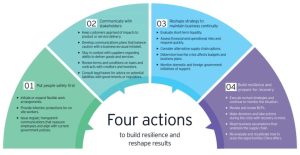How Does The Excessive Loan Of Real Estate Work

Excessive loan is short-term commercial financing, which is to make up for your financial deficiency in the short to medium term, so that you can go from A to B. It is usually used by real estate buyers and investors, but it is also suitable for a range of other business purposes. When carrying out excessive financing, the borrower usually makes a first or second legal mortgage on your property.
How does excessive lending work?
Bridge loans allow you to buy real estate before selling existing real estate. It is also often used by people who want to finance renovation or new construction projects before obtaining traditional mortgages. Due to the short-term nature of financing, it is sometimes called “revolving loan”, “gap financing” or “intermediate financing”.
If you plan to purchase a new home with a transitional loan while waiting for the current home to be sold, use the right of the current home as a down payment for the purchase of the new home. Both enterprises and individuals can use excessive financing. Many products are customized for various purposes.
Transitional financing can be obtained from non bank lenders with loans in professional fields and professional brokers with access to institutions. You can get bridges in Britain, Spain, France, Germany, Austria and many other places in Europe. The United States is also very familiar with the transitional financing of commercial and residential real estate.
Commercial transitional loan is a kind of commercial financing. Similarly, you can obtain funds in a short time. If you have an exit policy that meets the eligibility criteria and considers the borrower effective, you can use the funds for multiple purposes. For example, some enterprises use excessive financing to increase working capital or cope with short-term cash flow challenges.
It is important to remember that bridge loans provide immediate cash flow, but the interest rate is higher, so collateral is generally required.
Enterprises can also obtain transitional loans while waiting for long-term financing. For example, a new company participating in equity financing can complete the financing within 6 months to pay the transfer fee. These costs may include wages, inventory, rent, utilities and other costs.
Excessive real estate loans
although you want to buy real estate, if you wait for the completion of the sale of existing real estate, transitional real estate loans may be useful. In this case, you can use the loan to buy a new property and pay for the time to sell the old property.
If you are a chain enterprise and part of it goes bankrupt, you can also use the real estate transitional loan. In most cases, you can add the monthly interest of the loan to the loan balance and settle it at the end of the period.
As long as there are shares, loan repayment methods and sufficient guarantees, even if the credit rating is not good, you can also obtain transitional real estate loans.
You can also use the real estate transitional loan:
Purchase real estate at auction.
Pay the update fee.
Purchase land for power generation.
Buy real estate that is not suitable for living. Pay until you can get a mortgage(or after the project is completed)
One of the advantages of excessive real estate loans is that the application process is usually fast. The online application is approved within 24 hours. After the application is approved, the fund can be collected within 2 weeks. The lender must evaluate your property and conduct necessary inspections first.
Sometimes you can pay the borrower to process your application more quickly.
Open and closed bridge loans
There are two types of conversion loans: open loan and closed loan. Closed bridge loan has a fixed repayment date. If you buy real estate and wait for the sale to be completed, You usually get this type of loan. There is no fixed repayment date for open-ended transitional loans, but they are generally repaid within 12 months.
Conversion Loan Description FAQ
What is excessive lending?
Transitional financing is generally a kind of short-term commercial loan. Before the loan can be fully repaid or a more permanent form of financing can be obtained, it is better to regard it as a temporary loan from a to b. That is “; bridge”; i remember, from one stage to another.
How does the bridge loan compare with the term loan?
Theoretically, the reason why they are different is that they are used for specific short-term purposes. Because term loans generally have more general business purposes. In fact, the speed of getting cash from your account is the main difference. Some lenders may take several weeks to complete term loans, but excessive loans may be completed within 24-48 hours.
What can I do with conversion financing?
Borrowers who provide excessive loans usually purchase and renovate real estate, which is a form of real estate development financing. They can be commercial buildings or residential buildings. The project can be the paint for real estate development, or it can only have a bathroom in the apartment.
As long as you explicitly exit, you can use the bridge financing for other short-term business purposes, although this depends on the borrower’s appetite for your plan.
What is the “exit” of excessive loans?
Withdrawal is what the borrower said. They are talking about how you will repay the transitional loan in full(together with interest charges), or move to a more permanent financial type, such as a term mortgage.
You will hear what we say about closed-end conversion loans and open-end conversion loans. A closed-end loan is a credit line with a fixed exit date.
For example, the sale of real estate to repay the loan has been in place. There is no fixed exit for open-end loans, so we can obtain open-end loans. For a period of time before “0”, we can discuss your choice here and which lenders are most suitable for your requirements.
What is the interest rate of bridge loan?
Given the professionalism of the loan, the interest rate for specific short-term purposes may be higher than that of traditional term loans.
You can sometimes choose to pay “accumulated” interest, which means a one-time payment at the end of the agreement period. This is a useful type of financing for those who do not have the required funds at the initial stage of the loan.
How can I use bridge loans to finance development projects?
Excessive loans are the key for real estate developers to use for project financing. Assuming that the developers own land and obtain the planning permission of the council, they can build small apartments. A good solution to the real estate development project is to share the costs with the company. Can obtain 3-6 months of excessive loans. This will provide them with funds to complete the work.
After the loan matures, it will sell apartments or individual apartments, or transfer the medium-term loan to long-term financial products such as commercial mortgage loans, and repay them in full.
Conversion loans can sometimes be used in other business areas that may require short-term temporary loans, which means that loans have a clear “exit”.
Non standard transitional loan
Subordinated transitional loans usually exist because customers find themselves unable to obtain alcohol or transitional financing, and they want to purchase real estate, which may be caused by the following reasons:
The sources of income are complex.
Dishonor or no previous credit rating.
Non standard personal circumstances or loan requirements.
Non standard transitional financing should really be your last resort. Because your family, friends, mortgage lenders, and subprime borrowers are exhausted. Because interest rates and fees are high. Failure to repay the loan at the end of the transitional loan will cause very serious consequences.
The personal transitional loan institution charges an interest rate of about 0.5-1.5% per month, and the monthly fee charged by the borrower is 1-3% of your loan amount.
The typical transition period for individual loan institutions is 6 months or 12 months, and the interest has been accumulated and added to the loan. At the end of the bridge, how to repay all the money is the key to understanding the idea of the bridge lender.
The borrower is not interested in your income, job or credit history. Because they will lend you according to your repayment method. Because this is classified as a sub loan. I mean “end” strategy, which is a word you will hear when you talk to the borrower at the beginning
This exit strategy is a decisive factor in understanding whether you can obtain financing, and how can borrowers get their money back? They will not make money unless you repay all the accumulated interest on the loan, so exit should be feasible, realistic and feasible.
For example, if you want to borrow 100000 pounds to sell a house you bought for 200000 pounds at auction for 450000 pounds, what is the way out for the borrower? It’s easy. You completed the real estate transformation and sold the house on the market. If the borrower knew that the work would take six months, the value would increase to 450000 pounds. Then you will have six months to sell. Then they will gladly accept the arrangement.
What are the costs of over lending?
This depends on the situation of the loan – in general, the loan arrangement is fee based and, like all products, an administrative fee is charged. It depends on the borrower, so you can always explain complex terms and conditions.
How to provide transitional loans for real estate transformation?
This is a good refurbishment and refurbishment product. Because you will get the money soon, you can start work immediately.
In fact, transitional loans are often used to convert real estate into a state where borrowers can provide commercial collateral. Not all real estate is eligible for some type of mortgage loan – you can use excessive financing to complete this work, so that the real estate can enter a state where you can exit, and become a full term mortgage loan.
Can a transitional loan purchase real estate in an auction?
Yes, many buyers use transitional loans in auctions to help them buy, rather than traditional suppliers. Because the program there is much longer. After all, you usually bring money to the auction table within 28 days, so excessive lending is ideal. For more information about the auction fund raising and forecast, or refer to the auction real estate purchase guide.
What is the difference between the first and second excessive loans?
If the real estate you guarantee has no other loan guarantee, you will get the first transitional loan. However, for example, if you have obtained a loan for the real estate and its mortgage has not been repaid, the second fee bridging loan will apply.
Are you eligible for excessive loans?
The borrower will consider various factors before deciding whether to qualify for the transitional loan. Property is usually required as security and proof of income may be required in accordance with the terms of the loan. If you are applying for a transitional loan for business purposes, you may need to show evidence of your business plan.
How much bridge loan can I borrow?
How much you can borrow depends on the value of the property you use as collateral. Generally speaking, you can go from 5000 to 250 million pounds. LTV is usually between 65 and 80%
Where can I apply for a transitional loan?
You can use Platinum Global Conversion Finance to find conversion loans. Commercial banks, mortgage brokers and other professional lenders provide excessive financing. This process is very fast. -The decision is usually made within 24 hours, and the fund transfer takes about 2 weeks.
What is the interest rate of the conversion loan?
Like most loans, the bridge loan interest rate can be either fixed or variable. If the interest rate is fixed, the loan period will not change, so the monthly payment remains unchanged. If there is a change, the interest rate may change. Generally speaking, the borrower sets the variable interest rate according to the benchmark interest rate of the Bank of England.
The interest rate of conversion loans is generally higher than that of other types of loans. In addition, people who have not yet repaid their mortgages may eventually have to pay their mortgages and excessive loans until they are sold. The interest rate is the main cost of raising the conversion funds, but the following additional costs should be considered:
The distribution fee is generally 1-2% of the amount borrowed from you
Intermediary fees(if using intermediaries to find transfer funds)
Some lenders will receive an exit fee of about 1% of the loan amount









